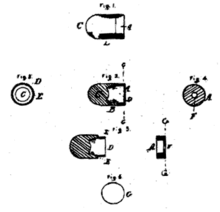Rocket ball
The Rocket Ball (in German about rocket ball ) was one of the first cartridges for small arms and at the same time one of the first caseless cartridges . It was developed in 1848 by the American inventor Walter Hunt from New York. U.S. Patent 5,701 is dated August 10, 1848.
Into the hollow end of the minié ball similar projectile was black powder were charged. The patent drawing shows that the cavity in the bullet was much larger than that of the Minié bullets. The end was closed with a disc made of cork. A small hole in the cork washer was sealed with paper. The spark of a percussion cap , which was ignited by the external tap like a percussion rifle , could penetrate the paper and thus cause the propellant charge to explode .
Since the primer cap was not part of the cartridge, it cannot be described as a modern unitary cartridge. Despite the name Rocket Ball , the projectile does not have a rocket drive . Nevertheless, the cartridge is brought in connection with rocket projectiles, as the construction is very similar.
One year after the cartridge, Hunt developed the first experimental lever action rifle "Volition repeater", which could fire the Rocket Ball. The cartridge was robust enough to fill several of them in the tubular magazine attached under the barrel , which made this the first practically usable bolt-action weapon . By 1852, a few hundred pieces of the somewhat further developed “Jennings rifle” had been built. Economically, however, the rifle with the "Rocket Ball" cartridge was a failure. In addition to the teething troubles with the repeating mechanism, the problem was that the cartridge did not perform well. The muzzle energy was about 76 joules , which was less than that of the later small caliber cartridge .22 lfB (see also energy of projectiles ). However, the concept did not allow an increase in the amount of propellant charge.
From 1854 to 1856, Horace Smith and Daniel Wesson (later Smith & Wesson ) manufactured repeating pistols and rifles for rocket balls in Norwich, Connecticut, they fired rocket ball ammunition with new primers . The production of these Volcanic carbines and pistols was taken over by Oliver F. Winchester in 1856 and discontinued around 1860, as rimfire cartridges prevailed in 1860 . With the disappearance of the Volcanic weapons, the production of Volcanic ammunition was also given up.
swell
- Wayne Van Zwoll: Hunter's Guide to Long-Range Shooting, Stackpole Books, 2006, ISBN 9780811733144 [1]
- Sam Fadala: The Complete Blackpowder Handbook, Gun Digest Books, 2006, ISBN 9780896893900 [2]
- http://www.leverguns.com/articles/taylor/history.htm Jim Taylor, Leverguns ( accessed June 11, 2010)

